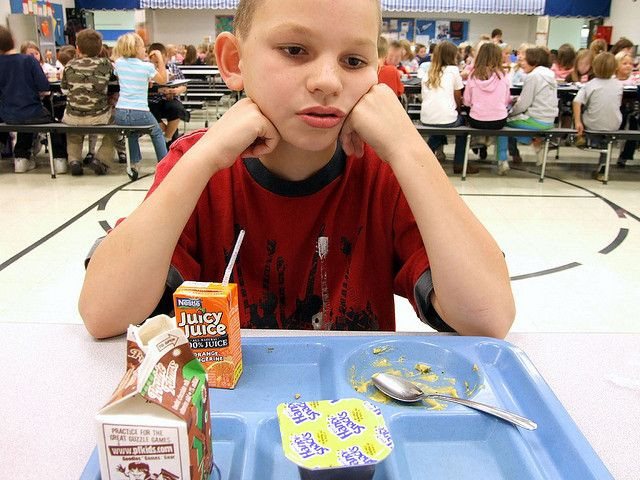USDA Bans Junk Food From Schools, But 100% Fruit Juice And Low-Quality Vegetables Won’t Make Kids Healthier

Beginning July 1, 2014, as mandated by the U.S. Department of Agriculture, schools will no longer be allowed to sell unhealthy junk food in their cafeterias, vending machines, student stores, or at bake sale fundraisers. Schools must replace these unhealthy items with a number of nutritious options, which also come with their own requirements.
While the ban’s intentions are in the right place, its provisions leave ample room for loopholes. Many of the new ingredient requirements take items that are otherwise healthy when consumed in moderation and replace them with sugary substitutes, which rely on artificial and processed sweeteners for flavor. In the long-run, these changes may end up putting kids at a larger disadvantage than if they had access to some of their original choices.
What’s New?
The USDA has made it restrictions specific. Competitive foods (those being sold commercially through the school) must either be fruits, vegetables, dairy products, protein-rich foods, whole grain-rich foods, or combination foods that have at least one-quarter cup of fruits or vegetables. Interestingly, schools can continue selling certain foods until July 1, 2016, as long as they contain at least 10 percent of the daily recommended value of potassium, calcium, or fiber. (Lay’s potato chips, for reference, contain nine percent of your daily recommended potassium; although, their calories from fat make them unfit after 2016.)
Then there are the nutrient limitations on those ingredients. All competitive foods must stick to the following nutrient limits:
a. Calories
• Max 200 calories for snacks and sides
• Max 350 calories for entrees (outside the school lunch program)
b. Sugar
• Max 35% sugar by weight (some fruit exceptions)
c. Sodium
• Max 230mg sodium for snacks (200mg after July 1, 2016)
d. Fat
• Fat: Max 35% calories from fat (as packaged or served; some exceptions for reduced fat cheese and nuts apply)
• Sat fat: Max 10% calories from fat (as packaged or served; some exceptions for reduced fat cheese and nuts apply)
• Trans-fat – 0g as served
Beverages carry similar restrictions: Schools can sell water, low-fat milk, flavored or unflavored fat-free milk and soy alternatives, and 100 percent fruit or vegetable juice. High school students are free to drink caffeine and certain low-calorie beverages that are flavored and carbonated, provided they also meet certain restrictions.
Where the Ban Fails
By the time kids reach their first birthday, they’ve already started developing a taste for certain foods — their tiny brains having formed complex associations between foods that please their palates and those that end up on a dirty bib someplace. They learn early on, for instance, that bread and sugar have appetizing textures in their mouth. Meanwhile, flavorless vegetables and uninteresting fruit, despite being packed with natural sugars, are a chore to eat. Should it be any wonder that by the time they reach elementary school, taking away their beloved snacks will be met with resistance?
This isn’t to say kids shouldn’t be made to eat their foods, but children are fickle. They’ll sooner throw away something they don’t like than choke it down because it’s “good for them.” All this really means for schools is wasted food. A study released earlier this year found that even though low-income kids began eating more fruits and vegetables when they were made mandatory, their waste levels did not decrease. In other words, they were eating better, but at a greater cost to the school with equal amounts of food in the trash.
The food won’t necessarily be any healthier either. The ban prohibits soda but encourages 100 percent fruit juice. Juices like apple juice and orange juice indeed contain necessary vitamins that promote healthy body function, yet per ounce certain brands contain exactly as much sugar as Coca-Cola.
Milk fat as well gets a poor reputation in the collective consciousness. Fat, itself, isn’t what makes you fat. Excess sugar and salt are the real culprits, retaining water and causing an insulin spike that deposits energy from food into fat cells. Fat from milk is a dietary plus. One study published early this year found a high dairy fat intake was associated with lower central obesity while a low dairy fat intake had the opposite relationship.
What to Take Away
The upshot to all this is that fruits and vegetables carry the greatest selling power when they’re prepared well and eaten when fresh. The logistics and funding involved to bring steady supplies of fresh leafy greens, ripe tomatoes, juicy peaches, and bright green beans are insurmountable at a national level, motivating the need for canned fruit packaged in syrupy baths.
Quality already tends to take a backseat to expediency in the U.S. when it comes to the food we eat. Why should picky eaters behave any differently?
Published by Medicaldaily.com



























